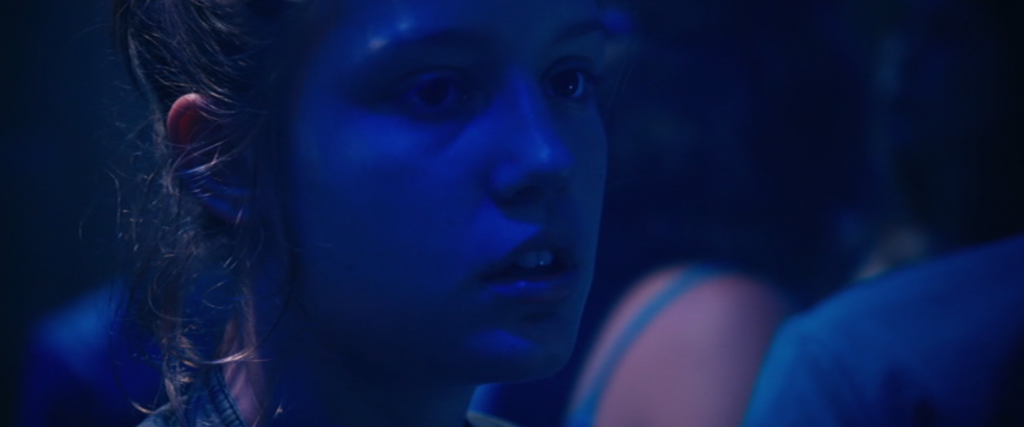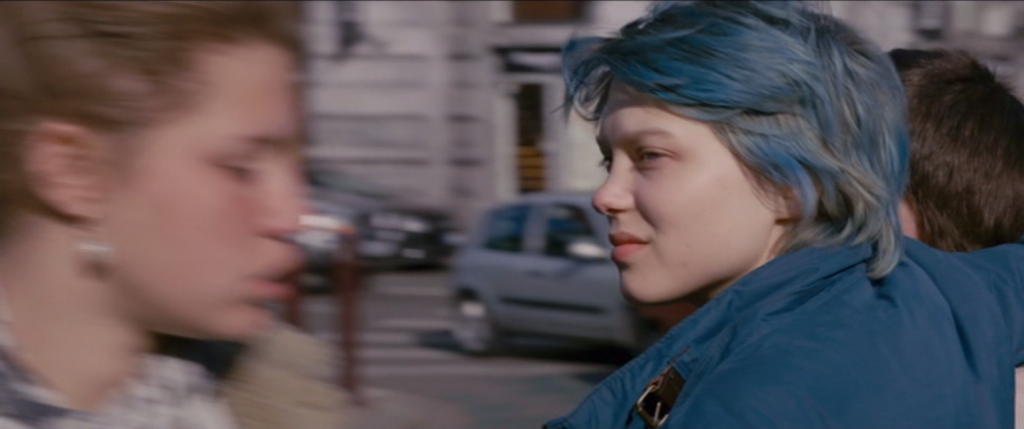In American cinema, fate is often presented as a path leading to success – especially when it comes to love. People meet, fall head-over-heels for one another, experience a setback or two, then live happily ever after. In films outside of Hollywood, love stories are more realistic, and more in tune with subjective experiences of love. In real life, you have to learn how to love. You have to know who you are before turning to others for deep-seated romantic connection. Love at first sight, though, does exist in real life. Maybe not a long-lasting, grow old together, kind of love; but a life-altering spark, where you absolutely need to experience a particular person. Blue is the Warmest Color deals with this kind of love. Similar to both her and Stranger by the Lake, Blue revolves around a character who is lost. Unlike those films, though, Blue is epic in scope. With a running time of just under 3 hours, and a narrative spanning 4 to 5 years, the film is an ambitious coming-of-age tale. As opposed to showing a character within a certain point, we watch as Adèle (Adèle Exarchopoulos) begins and ends an entire period in her life, a time that is necessary for her to discover who she wants to be.
The defining theme of Adèle’s discovery is fate, and it is maintained through a repetition of editing patterns and shot selection, but also through narrative content and the presence of the color blue. Whether in the background, foreground, or on the characters themselves, the color blue is uncannily present in the film. The constant recurrence of the color functions as a confirmation of Adèle’s fatalistic path, in the same sense, as say, when people believe the recurrence of ascending numbers symbolizes good fortune.
Adèle is beautiful, intelligent, charismatic, and intensely passionate. She is unsure of what to do, though. She turns to others for guidance and experience, yet is powerless to be anything but herself. There is no phoniness with Adèle. She is a woman with tremendous strength and individuality – yet one who hasn’t fully realised it yet. Enter Emma (Léa Seydoux). Emma is older, wiser, and more calculated. The two hit it off right away, and although the film is centered on their romance, it is Adèle’s sense of self-discovery that Kechiche is most concerned with. (The original French title is La vie d’Adèle: Chapitres 1 & 2.) He and cinematographer Sofian El Fani employ a variety of close-ups and medium close-ups to bring depth and intimacy to the characters, but it is Adèle’s point of view that remains dominant. From shots of her lying in bed, stuffing her face with food, or observing a crowd, Kechiche leaves the camera on her, and Exarchopoulos’ performance is nothing short of brilliant.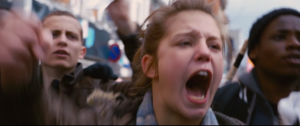

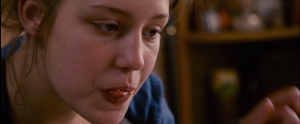
The close up of the face is one of the most widely used shots in cinema. It can be used to portray emotion, and it also functions as way of limiting the cinematic space to a single image. On its own, the face is a canvas for identity; the part of the human body that is regularly viewed and read by others. When featured in close up, the face becomes detached from the body, leaving the viewer to discern why.
Throughout Blue, Adèle’s face contorts through every sensation imaginable, sometimes all within the same scene. The use of close-up both contains and limits her (metaphorically and literally within the frame), but it also draws attention to what is under the surface, as she is uniquely alive in the sense that there is this amazing, vibrant personality waiting to be unleashed. By employing this method, Kechiche is able to showcase Adèle’s inner struggle, without relying heavily on exposition.
By focusing so intently on Adèle during seemingly empty sequences of narrative action (sleeping, eating, and so on), Kechiche draws attention to the role of the gaze. By placing the audience in a position to look at Adèle when she is vulnerable, her everyday nature shines through, allowing the film to embrace a humanist perspective, and present an individual story with universal appeal. Through close-up, Adèle’s interiority is presented as authentically as possible, as the camera gets under her skin in ways only cinema can provide. However, as viewers, our position also re-affirms the notion that Adèle is trapped by others. We watch and judge; her image controlled by both the camera and our gaze.
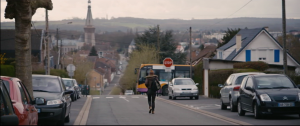 In contrast to the close-up, long shots are often used when Adèle is either on the move or in motion. Take the opening of the film: the camera captures her in long shot as she exits her house and stays on her (becoming an extreme long shot) as she moves away from the screen. Near the end of the shot, she runs after a bus, only to miss it. The next shot is a close up of her face as she sleeps on the train. The contrast between the two shots establishes a formula Kechiche will repeat throughout the film: a sort of start-stop dynamic meant to showcase the slow pathway of discovery Adèle is on, while simultaneously displaying her struggle with autonomy.
In contrast to the close-up, long shots are often used when Adèle is either on the move or in motion. Take the opening of the film: the camera captures her in long shot as she exits her house and stays on her (becoming an extreme long shot) as she moves away from the screen. Near the end of the shot, she runs after a bus, only to miss it. The next shot is a close up of her face as she sleeps on the train. The contrast between the two shots establishes a formula Kechiche will repeat throughout the film: a sort of start-stop dynamic meant to showcase the slow pathway of discovery Adèle is on, while simultaneously displaying her struggle with autonomy.
In regard to the narrative, the first scene in which fate is mentioned is during one of Adèle’s literature classes. Using La Vie de Marianne, by Pierre de Marivaux, as a reference point, her teacher asks the class to consider what love at first sight means in regard to the glance, and how one’s life is influenced from that point forward. The sequence foreshadows the soon-to-be meeting of Adèle and Emma, and it also establishes a motif for the remainder of the film.
When Adèle first lays eyes on Emma, they are standing on opposite sides of the street. Upon crossing, Emma meets Adèle’s glance but does not stop walking. Adèle, on the other hand, is totally thrown off guard. She stops, spins, and loses all context of where she is, and the camera mimics this confusion through a series of close-ups and medium close-ups, while also breaking the 180-degree rule. At this point, we are given a prelude to the life-altering experience of Adèle and Emma’s relationship. The two women will meet, passionately share a period of their lives together, and then go their separate ways. Emma will continue on the path she was already on, but Adèle’s world will be turned upside down, and it will be solely up to her to pick up the pieces and move forward. This is her fate. She must immerse herself in something and then experience tragedy to learn and grow.
Aside from necessary establishing shots, long shots are used sparingly in the sequences where Adèle and Emma and are getting to know each other – that is, until the clothes come off. The first and longest of the film’s sex scenes has been heavily debated since the film’s release; still, the aesthetic has a definite purpose within the overall context of the film. (There is a great essay by B. Ruby Rich detailing the backlash and the history of the controversy, available at Criterion.) The two women’s bodies are put on display in a manner that suggests release and freedom, not only for the characters, but for the spectator as well. Adèle and Emma experience and embrace each other through a variety of poses and positions meant to signify absorption. And because of the film’s continued display of the face in close-up, it is a relief to see a series of medium and long shots (there are still plenty of close-ups thrown in) of bodies in motion. For Adèle, this is the experience she so desperately needs, as she is now able to put everything she has into something meaningful. For the audience, it is a chance to finally see her let loose and express some of the desire she has been holding in. The moment does not last long, though.
When Adèle is first introduced to Emma’s parents, the evening is slightly tense, and the camera acts as an emotional guide. When they arrive, close-ups and medium shots consistently block the characters together, but as soon as it is revealed that Emma has failed to inform her parents that Adèle dislikes shellfish (a point made very clear to Emma), the camera stays in either close-up or medium close-up and stays focused on one character at a time. When the conversation veers into career aspirations, both Adèle and Emma take subtle shots at one another’s choices (Emma is pursuing academia and a career in art; Adèle wants to teach elementary school), and the closeness of the camera feels almost smothering – cue the next sex scene.
The film abruptly cuts to a heated and—for lack of a better word—innovative display of eroticism. In one striking long shot, the two lovers are intertwined in a kind of picturesque scissor position designed for mutual satisfaction. Far from mere glorification, this move from confinement to shared ecstasy is designed to showcase the women’s intense physical connection for each other, and it is no coincidence that the sequence interrupts the claustrophobic atmosphere of the earlier dinner scene. Here, Kechiche is stressing the growing need for the lovers to maintain their lust, because they are not on the same page in their lifestyles. The same thing occurs when Emma meets Adèle’s parents as well: awkward conversation featuring single faces in close up, cut to a sex scene.
 After establishing a dynamic of tension and lust, the film returns solely to Adèle’s interiority. Featuring a subtly uncomfortable party, Adèle tries her best to be what she thinks Emma wants her to be, only to feel even more alone because of it. Throughout the event, Adèle cooks, serves, cleans, and politely listens to others, and quickly feels out of place. Her alienation is further reinforced by the ever-present image of Lulu (Louise Brooks) from Pandora’s Box playing in the background. Like Lulu, Adèle is seen by others as a canvas for beauty (Emma literally refers to her as a muse). And in Pabst’s film, Lulu is also photographed in a variety of close-ups, and her face is presented as the “very image of desire” (Mary Anne Doane, from the commentary on the Pandora’s Box Criterion DVD). She is a performer and wants to be adored, but she also yearns for sexual freedom and cannot escape the constraints of the masculine world. In comparison, Adèle is searching for the freedom to love herself; a freedom she will never obtain so long as she is forced to be what others want her to be. Expressing herself sexually is her first step forward, but the eventual demise of her and Emma’s relationship shows that this is not enough.
After establishing a dynamic of tension and lust, the film returns solely to Adèle’s interiority. Featuring a subtly uncomfortable party, Adèle tries her best to be what she thinks Emma wants her to be, only to feel even more alone because of it. Throughout the event, Adèle cooks, serves, cleans, and politely listens to others, and quickly feels out of place. Her alienation is further reinforced by the ever-present image of Lulu (Louise Brooks) from Pandora’s Box playing in the background. Like Lulu, Adèle is seen by others as a canvas for beauty (Emma literally refers to her as a muse). And in Pabst’s film, Lulu is also photographed in a variety of close-ups, and her face is presented as the “very image of desire” (Mary Anne Doane, from the commentary on the Pandora’s Box Criterion DVD). She is a performer and wants to be adored, but she also yearns for sexual freedom and cannot escape the constraints of the masculine world. In comparison, Adèle is searching for the freedom to love herself; a freedom she will never obtain so long as she is forced to be what others want her to be. Expressing herself sexually is her first step forward, but the eventual demise of her and Emma’s relationship shows that this is not enough.
In the final sequence, Adèle is shown preparing for and attending a gallery showing of Emma’s art. We watch Adèle shower, paint her nails, and with the camera placed behind her shoulder—beginning in a medium close-up and cutting to a long shot—we see her look at her reflection for the first time in the film. This is significant because it is the first occasion where she controls the gaze, thus making a step toward change. The moment is quick—as the scene ends with yet another shot of her face in close-up—but the beginning of her new chapter has been alluded to; she has finally drawn a line in the sand and decided this is the last time she will pursue Emma. Notice also that her reflection is further from the camera than her body is, suggesting she still has this last hump to go over.
When walking to the gallery, Adèle is tracked by an extreme long shot (turning into a long shot) as she approaches. Inside, conversations play out in the same awkward way as the earlier backyard party, the difference being that Adèle has the power to leave. And leave she does, but not before getting closure. The camera follows while she fidgets and grows increasingly uncomfortable with the situation. After a forced conversation with an admirer (whom she met at the aforementioned party), she takes one last look at Emma, leaves, and accepts that their relationship is over. When she exits the gallery, the camera captures her in close up but shifts when she reaches the corner of the sidewalk and turns right. Her admirer runs out to see where she is, but goes the wrong way, and diegetic music from an earlier scene (when Adèle first saw Emma) begins to play non-diegetically. Its presence (the only time non-diegetic music plays in the film) signifies the official end of this chapter in Adèle’s life; she has experienced love in all its glory and heartbreak, and she can now move forward and seek fulfillment on her own terms. When Adèle turns the corner, she is walking away from the screen. With the film ending with her in motion, we watch as she literally moves into the next chapter of her life (and out of the film), her face nowhere in sight.
Throughout Blue, the camera never places Adèle in a position to be pitied. Instead, the film’s sense of tragedy comes from a desire to spread humanistic ideals. In comparison to intense suffering, her struggle is by no means dire—in fact, it is quite ordinary for someone her age—but through close-up and manipulation of space (not to mention, top-notch acting), the interior nature of her world is brought to the public sphere, and this is no minor feat. With a focus on self-worth, Blue is the Warmest Color is a testament to the power of young love. And although it embraces fatalist sentiments, this can be viewed as allegory for the potentially trans-formative experience of controlling the gaze and not allowing others to determine who you are.
— Griffin Bell



